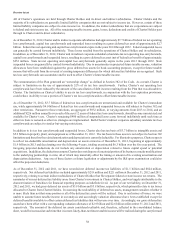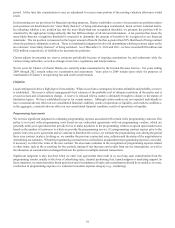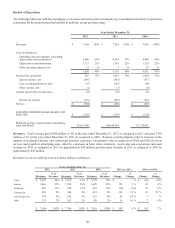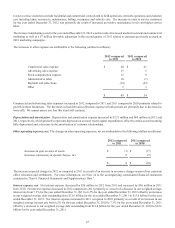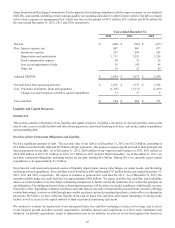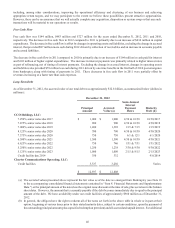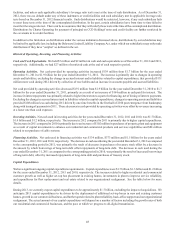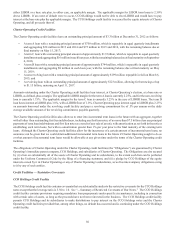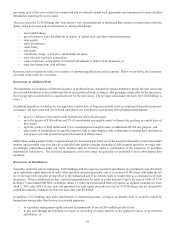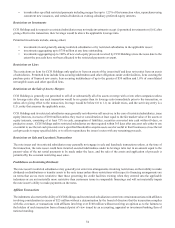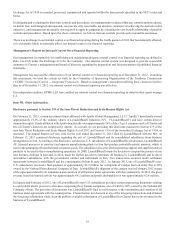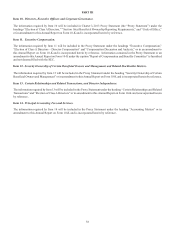Charter 2012 Annual Report Download - page 60
Download and view the complete annual report
Please find page 60 of the 2012 Charter annual report below. You can navigate through the pages in the report by either clicking on the pages listed below, or by using the keyword search tool below to find specific information within the annual report.48
facilities, and unless each applicable subsidiary’s leverage ratio test is met at the time of such distribution. As of December 31,
2012, there was no default under any of these indentures or credit facilities and each subsidiary met its applicable leverage ratio
tests based on December 31, 2012 financial results. Such distributions would be restricted, however, if any such subsidiary fails
to meet these tests at the time of the contemplated distribution. In the past, certain subsidiaries have from time to time failed to
meet their leverage ratio test. There can be no assurance that they will satisfy these tests at the time of the contemplated distribution.
Distributions by Charter Operating for payment of principal on CCO Holdings' notes and credit facility are further restricted by
the covenants in its credit facilities.
In addition to the limitation on distributions under the various indentures discussed above, distributions by our subsidiaries may
be limited by applicable law, including the Delaware Limited Liability Company Act, under which our subsidiaries may only make
distributions if they have “surplus” as defined in the act.
Historical Operating, Investing, and Financing Activities
Cash and Cash Equivalents. We held $7 million and $2 million in cash and cash equivalents as of December 31, 2012 and 2011,
respectively. Additionally, we had $27 million of restricted cash at the end of each respective period.
Operating Activities. Net cash provided by operating activities increased $139 million from $1.7 billion for the year ended
December 31, 2011 to $1.9 billion for the year ended December 31, 2012. The increase is primarily due to changes in operating
assets and liabilities, excluding the change in accrued interest and in liabilities related to capital expenditures, that provided $131
million more cash during 2012 driven by collection of receivables and an increase in accounts payable and accrued liabilities.
Net cash provided by operating activities decreased $191 million from $1.9 billion for the year ended December 31, 2010 to $1.7
billion for the year ended December 31, 2011, primarily as a result of an increase of $164 million in cash paid for interest. The
increase in interest payments was primarily related to higher interest rates as part of refinancing, net of timing of interest payments.
Excluding the change in accrued interest and in liabilities related to capital expenditures, changes in operating assets and liabilities
provided $108 million less cash during 2011 driven by one-time benefits in the first half of 2010 post emergence from bankruptcy
along with timing of payments in 2011. These decreases in cash provided by operating activities were offset by revenues increasing
at a faster rate than cash expenses.
Investing Activities. Net cash used in investing activities for the years ended December 31, 2012, 2011 and 2010, was $1.7 billion,
$1.4 billion and $1.2 billion, respectively. The increase in 2012 compared to 2011 is primarily due to higher capital expenditures.
The increase in 2011 compared to 2010 is primarily due to an increase of $102 million in purchases of property, plant and equipment
as a result of capital investments to enhance our residential and commercial products and services capabilities and $88 million
related to our purchase of cable systems.
Financing Activities. Net cash used in financing activities was $134 million, $373 million and $1.5 billion for the years ended
December 31, 2012, 2011 and 2010, respectively. The decrease in cash used during the year ended December 31, 2012 as compared
to the corresponding period in 2011, was primarily the result of decreases in purchases of treasury stock offset by a decrease in
the amount by which borrowings of long-term debt offset repayments of long-term debt. The decrease in cash used during the
year ended December 31, 2011 as compared to the corresponding period in 2010, was primarily the result of increased borrowings
of long-term debt, offset by increased repayments of long-term debt and purchases of treasury stock.
Capital Expenditures
We have significant ongoing capital expenditure requirements. Capital expenditures were $1.7 billion, $1.3 billion and $1.2 billion
for the years ended December 31, 2012, 2011 and 2010, respectively. The increase related to higher residential and commercial
customer growth as well as higher set-top box placement in existing homes, investments in plant to improve service reliability,
and expenditures for fleet replacement and real estate related to our organizational realignment. See the table below for more
details.
During 2013, we currently expect capital expenditures to be approximately $1.7 billion, excluding the impact of acquisitions. We
anticipate 2013 capital expenditures to be driven by the deployment of additional set-top boxes in new and existing customer
homes, growth in our commercial business, and further spend related to plant reliability, back-office support and our organizational
realignment. The actual amount of our capital expenditures will depend on a number of factors including the growth rates of both
our residential and commercial businesses, and the pace at which we progress to all-digital transmission.


